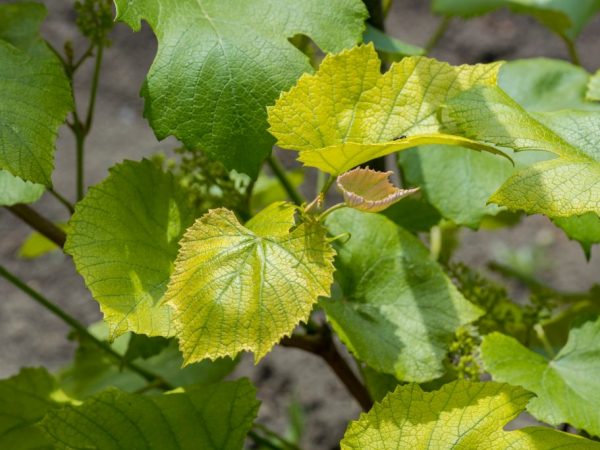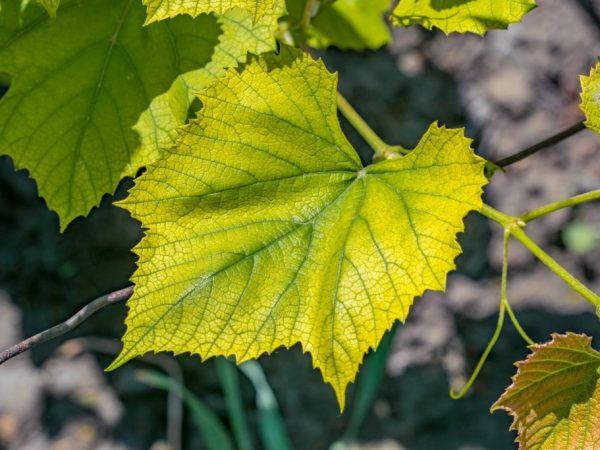Causes of yellowing of grape leaves
Growing grapes is a complex process. What makes the leaves of grapes turn yellow is determined, based on the external data of plants, the composition of the soil. The main reason for worsening the condition of the ground part is poor quality care.

Causes of yellowing of grape leaves
Causes of the unstable state of plants
The yellowing of grape leaves occurs for a number of reasons:
- lack of trace elements;
- pests;
- sunburn.
Depending on the factor, the treatment regimen is determined. Each cause of yellowing of grape leaves provokes the manifestation of additional symptoms at a certain time of the season.
Lack of micronutrients
Nitrogenous fertilizing is applied at the beginning of the growing season. With their lack in the soil, the process of growth and development of young shoots slows down. The leaves turn yellow in grapes, the root system is weakened. Fruiting specimens enter the flowering phase late, shedding the ovary.
Yellow streaks on foliage indicate zinc deficiency. The element takes part in redox processes, improves nitrogen metabolism. With its deficiency, a large amount of nitrogen accumulates in plant tissues. The foliage becomes asymmetrical, jagged, brittle. Another reason for the yellowing of the deciduous part is the lack of boron.
Yellow spots form in a mosaic pattern, then turn brown and die off. The ovary is weak, falls off ahead of time. In rare cases, yellowing is caused by a lack of molybdenum. The element takes part in water-nitrogen exchange, cell regeneration.
Decreased plant vitality, wilting and yellowing of foliage are due to a lack of manganese. The component ensures the absorption of other trace elements by the root system. It is easy to remedy the situation by making an aqueous solution with potassium permanganate. Foliage and soil are cultivated with it.
The problem is eliminated by introducing the missing element into the soil or using complex foliar dressing. Nitrogen is found in large quantities in lime and chicken manure. The nitrogenous compound is introduced in the spring, before the swelling of the buds, simultaneously with deep cultivation of the site. At a later date, the introduction of such dressings is impractical. An excess of nitrogen will provoke an increase in the growth of the terrestrial part of the plants, which will negatively affect the quality and quantity of the crop.
Pests
Insects and animals that love to feast on sweet fruits, juicy greens and roots actively reproduce in the summer. If the grape leaves turn yellow in June, the garden is checked for pests. The most common enemies of the vine are:
- aphid;
- onion fly larva;
- bear;
- mole.
Aphids eat all plants. It multiplies especially rapidly in nitrogen-rich soils. When the leaves of the grapes turn yellow and dry after fertilization, the inner parts of the leaf plates are examined. The pest settles there, feeds on juice.The optimal method of combating aphids is the introduction of complex fertilizing, consisting of potassium, phosphorus and nitrogen. The insect does not tolerate potassium supplements well, loses its ability to reproduce and dies.
The onion fly lays its eggs in the soil. In the process of growth, the larvae eat roots, leaves, and cuttings. In such cases, treatment is carried out with a manganese solution. For 5 liters of water, 1 g of potassium permanganate is required. Spraying is carried out daily for 5 days.

Pests adversely affect the plant
Medvedka digs deep holes, feeds on the root system. She is able to transfer all young seedlings on the site. You can fight the pest using traps or pouring a strong infusion of hot pepper into the holes. A jar buried in the ground is used as traps. The neck is left to stick out 1-2 cm above the soil level, honey or sugar is placed inside.
The mole is the most dangerous pest. It feeds on the roots of seedlings and adult plants. The mole is distinguished by a developed sense of smell. The main way to combat it is to use strong-smelling substances placed in burrows. Cotton wool moistened with mothballs or turpentine is placed in the mink. A large number of moles are destroyed with the help of aluminum phosphide, drugs "Mole Boy" or "Fighter".
Sunburn
The grapes turn yellow from an overabundance of sunlight. Yellowness appears as spots in the central parts of the leaf blade, leaving the edges intact. The fruits do not collect enough sugar, dry out and fall off prematurely.
If the leaves of the grapes turn yellow due to a burn, they are completely eliminated. The surviving shoots are shielded with a special sun-reflecting screen. The soil is treated with Kendal, Tekamin max or Megafol, an antistress drug.
Common diseases
Grape leaves turn yellow for many reasons. Several diseases are distinguished among them:
- chlorosis;
- mildew;
- alternaria.
Yellow leaves in grapes signal a violation of the production of chlorophylls. The leaf plates are stained between the veins. Chlorosis also manifests itself as yellowing of the entire ground part of the plant. The latent form of the disease occurs in the spring, passes at the beginning of summer, and then reappears. The main reasons for yellowing of leaves with chlorosis are a lack of fertilizers, weakening of plants.
It is customary to treat the disease by introducing mineral dressings into the soil. Superphosphates will fix the problem in 3-5 days. As a preventive measure, copper sulfate is annually introduced into the soil in the spring. If the leaves of the grapes turn yellow quickly, this may be the first sign of mildew, a fungal disease that affects individual varieties. When the temperature drops, the spores of the fungus fall into suspended animation.
With the onset of favorable conditions for development, the spores move downwind to the deciduous part of the plant and slowly destroy it. The fungus that causes Alternaria acts in a similar way. Treatment with Metalaxil effectively helps to cope with ailments of fungal origin.
Preventive actions
To prevent the culture from turning yellow, you need to properly organize its care. It is annually pruned to remove dead branches. Sanitary pruning is done in the spring. The procedure ends with prophylactic treatment and fertilization of the soil. The correct approach provides plants with nutrients, allows you to destroy fungal spores and larvae of pests.
After pruning, all plant waste must be disposed of. The soil is dug to a depth of 15 cm. Nitrogen fertilizers or superphosphates are applied. Before flowering, the leaf plates are treated with copper sulfate. After flowering, potassium fertilizers are applied.
In the spring, before the kidneys swell, they are treated with insecticides ("Nitrafen"), if there have already been incidents with diseases. In the fall, a similar procedure is performed. Treatment with chemicals, if necessary, continue throughout the season until the grapes are poured. In the fall, the vine is wrapped in burlap.
There are a number of biostimulants that can accelerate growth, increase yields, and protect against pests. Nutrient complexes include a number of trace elements and phytohormones that activate the protective functions of the plant organism. The preparations are applied at any stage of the growing process in the form of root and foliar dressings. They increase the yield increase by 10-50%. The most popular products in this group are Kornevin, Zircon, Stimax Harvest, Universal.
Conclusion
Grapes are a finicky culture. Improper care, deterioration of soil quality, diseases most often lead to yellowing of leaf plates. Eliminate unpleasant symptoms, focusing on the reasons that caused the weakening of the bushes.

